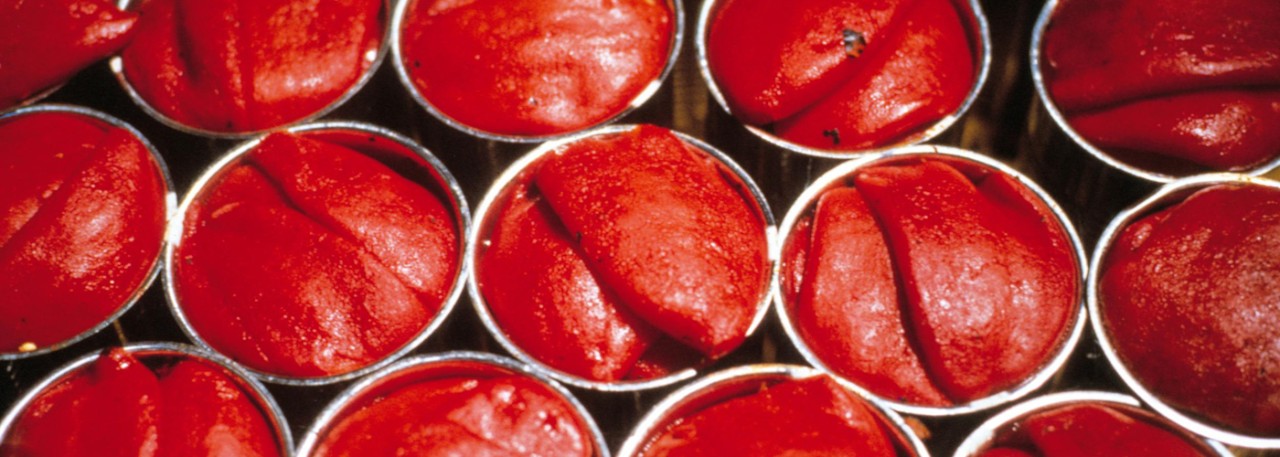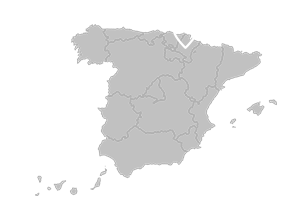.png.transform/rendition-xs/image_image%20(1).png)
Pimientos del Piquillo de Lodosa PDO
Canned whole, in strips or chunks roast peppers, categories Extra and Primera, of the species Capsicum Annuum L., of the indigenous variety Piquillo, cultivated and prepared exclusively in Navarre.
Tasting notes
They have a sweet, non-acidic flavour, with a certain roasted aftertaste and a meaty, consistent and well-rounded texture, without being tough.
Other notes
With an intense red color and triangular shape, the pepper has two or three faces, ends in a sharp point, and is slightly curved. It is small in size, some ten centimeters (3.9 in) long, with an average diameter of four to five cm (1.6 – 2 in). On average each pepper weighs 35 to 50 g (1.23 - 1.76 oz), with very thin flesh (approximately 0.3 cm (0.1 in)).
Production / Processing method
The Piquillo de Lodosa pepper is a yearly herbaceous plant. The fruit grows hanging from the plant, which has high vegetation development. Sowing is carried out in seed beds during the first month of March, and the plant is transplanted to the soil in the first week of May. Planting is carried out with exposed roots, at a density of 0.90 m (35.4 in) between rows and 0.30 m (11.8 in) between plants, resulting in some 37,000 plants per hectare (2.47 acres).
When the plant takes root the surrounding land is cleared of weeds, so that the soil on the hill can be moved and the plant ends up on the top. A cover of fertilizer is carried out, with low doses of nitrogen and light irrigation, every ten to 12 days.
Harvesting of the fruit is manual and gradual (directly from the plant), and is carried out every ten or 15 days, when the peppers are sufficiently ripe. It normally begins in the second half of September, lasting through to mid or end November. Only those peppers which are developed and ripe enough to withstand handling, transport and the production process are picked.
When the fruit is received in the factory, it may be stored in a covered, well-aired area for a maximum of seven days, to improve its color.
Once the product has been selected, and any defective, damaged, torn or low-color peppers have been discarded, it is placed in a hopper with boiling water, to remove any impurities from the field. The peppers are then placed in an oven, where they are exposed to a direct flame. Alter roasting, they are peeled, and the core and seeds are removed. This is done by hand, and the skin, stalk and the meaty section which holds the seeds are all removed. The peppers are peeled one by one, without being submerged in water, to ensure that they retain all their natural characteristics.
They are then classified by size and color, to guarantee uniformity, and are then placed in cans or glass jars. Packaging is done in dry conditions, thus preserving the juices released from the peppers. Once packaged, the product is sterilized to destroy any micro-organisms, and to ensure that it retains its aroma, flavor, consistency, sugars and natural fats. Once the heat treatment has finished, the cans are cooled as soon as possible to prevent the product from overheating.
Once all the above processes have concluded, and the containers have been marked, they are stored for a time to ensure that the product can withstand transportation.
Geography / Relief and climate
This region in Navarre, called Ribera Baja or Ribera Meridional, is crossed by the River Ebro and its tributaries, the River Ega, on the banks of which the majority of production is carried out, and the River Arga. It has a flat landscape with stepped plains which drop from an altitude of 500 to 250 m (1,640 – 820 ft). This area is predominated by brown limestone soils on unconsolidated material, made of shale from the Miocene. In addition, the area also has extensive alluvial areas. With its semi-arid climate, the region is hot and dry from May to September, with abundant fog in winter. Rainfall is scarce, with annual figures reaching approximately 400 mm (15.7 in).
Regulatory Council
The Institute for Agrifood Technology and Infrastructures of Navarre (INTIA)
Avd. Serapio Huici, 22 - Edificio Peritos
31610 Villava (Navarra)
Tel: (+34) 948 013 045
piquillolodosa@intiasa.es
www.denominacionesnavarra.com
Sources:
- Spanish Ministry of Agriculture
- The Institute for Agrifood Technology and Infrastructures of Navarre (INTIA)
The peppers are placed in a hopper with boiling water, after that they are placed in an oven, exposed to a direct flame. Then are peeled, and the core and seeds are removed.


- /content/dam/en/icex-foodswines/images/products/preserves/pimientos-del-piquillo-de-lodosa-pdo/Pimientos%20del%20Piquillo%20de%20Lodosa%20PDO%20carr1.jpg
- /content/dam/en/icex-foodswines/images/products/preserves/pimientos-del-piquillo-de-lodosa-pdo/Pimientos%20del%20Piquillo%20de%20Lodosa%20PDO%20carr2.jpg

Villava (Navarre)
